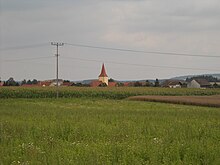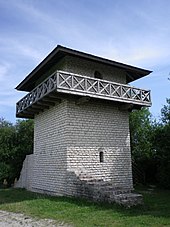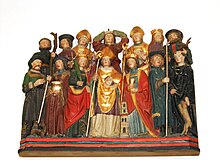Erkertshofen
|
Erkertshofen
Market Titting
Coordinates: 48 ° 58 ′ 42 ″ N , 11 ° 13 ′ 25 ″ E
|
|
|---|---|
| Height : | 527 m above sea level NN |
| Residents : | 372 |
| Incorporation : | May 1, 1978 |
| Postal code : | 85135 |
| Area code : | 08423 |
Erkertshofen ( Bavarian Aggatshofa ) is part of the municipality of the Titting market in the Eichstätt district in the Altmühltal nature reserve .
location
The place is located on the plateau of the southern Franconian Alb south of the Anlautertal on the connecting road Titting - Wachenzell 527 meters above sea level. The topographic data are: 48.9786 latitude and 11.2223 longitude.
history
Burial mounds from the Hallstatt period (beginning of the older Iron Age ) were found near the site; a hill opening from 1836 with three skeletons and additions was described in detail. In 1963 a spectacular grave place of the Latène period (Celtic period) was found in the corridor Erkertshofen - a richly furnished warrior grave with iron weapons.
The Upper Germanic-Rhaetian Limes Kipfenberg - Weißenburg in Bavaria , route 14, popularly known as the pile or devil's wall, runs through the village . A stone, three-storey observation tower of this Roman border wall, the guard post 14/63, was rebuilt as part of the Roman program of the district of Eichstätt 1989-92 on the eastern edge of the village based on a representation of the Trajan column in Rome , integrated into a Limes nature trail . In 1859 the Bavarian King Max II had a stone monument erected on the Limes wall between Erkertshofen and Petersbuch .
In the Middle Ages the place was called Erckenbrechteshouen (court of Erckenbrecht / Erchambrecht?), Then Erckertshofen . In a document from 1156 of the Augustinian canons Rebdorf there is an "Armiger-Bawaffneter" from Erkertshoven and thus the first documented mention of the place. In 1210, the Eichstätt bishop Hartwig exchanged a yard and a mill in Erkertshofen from the Benedictine monastery Reichenbach (near Nittenau) for vineyards near Regensburg to the Eichstätter cathedral chapter . 1239 confirmed Pope Gregory IX. the Rebdorf monastery in Erkertshofen. In 1243 the local nobility of the gentlemen “from Erkertshoven” is mentioned. In the dispute over the Hirschberger Heritage - 1305 the Counts was Hirschberger , who Eichstätter protective stewards, with Gebhard VII. Extinct - the place was the bailiwick rights and respect lower courts awarded the Eichstätter bishop and the Office of the bailiwick of Eichstaett, with headquarters on the Willibaldsburg and incorporated into the Seuversholz marriage detention court . This did not affect the subjects of the Eichstätter cathedral chapter at eight Erkertshofener courtyards, which were still subject to the cathedral capital court in Wachenzell , the most important of which were the Meier and Widdum courtyards. Accordingly, the people of Erkertshofer were taxable and subservient to either the bishop or the cathedral chapter. The exception was a single court, which until the secularization of 1803/06 was lendable to the "Prince of Brandenburg-Ansbach Collegiate Office Wülzburg ".
There was a school house in the village no later than 1700; it was demolished in 1893. In 1710, Erkertshofen, previously a branch of Emsing in the Anlautertal, became an independent parish. Having become Bavarian in 1806 , Erkertshofen was assigned to the Raitenbuch district court , which was relocated to Greding in 1812 . In 1862 the village was assigned to the Beilngries district office and from 1879 it belonged to the Hilpoltstein district office .
In 1965 land consolidation was carried out. In the course of the regional reform , the place only came to the Titting market on May 1, 1978.
The predominantly agriculturally oriented town had ten full-time and 29 part-time farms with 303 inhabitants in 1983. Around the place there are some Jura marble quarries with companies that process the coarse-beamed Jura limestone. To the south-east of Erkertshofen is a drainless depression with several sinkholes .
There are several legends about Erkertshofen (in dialect: Aggatshofa ), collected in the 1970s to 1990s by Emmi Böck (printed in the Titting book, pp. 233–235).
Churches and chapels
The Catholic parish church of St. Agidius was consecrated between 1183 and 1195 under the Eichstätt Bishop Otto . In 1708 the church including the tower was renovated and largely refurbished; the side altars (with younger altar leaves, showing St. Sebastian on the left, St. Mary on the right) and the pulpit date from this period. In 1904 new altars and frescoes were added to the church. In 1919/20 the nave was extended to the west. The brick helmet of the undivided tower has a special feature in that it has a half-timbered tower bay on the east side . The high altar contains elements of the previous Baroque altar from the early 18th century. There are some late Gothic wooden figures (St. Katharina , St. Barbara ; framed wooden relief of the 14 Holy Helpers , around 1520), but also Baroque figures ( Rosary Madonna on the choir arch - according to Mader "a good Baroque creation", Madonna with the baby Jesus, statuettes of Hell . Willibald and Walburga - according to Mader "good figures of the early 18th century"). On the outside of the north side of the nave there is an early Rococo epitaph made of limestone for the pastor Johann Anton Jobst, who died in 1738, "a good shepherd for his little sheep", created by the Eichstatt sculptor Carl Johann Schorer .
The parish, today cared for in pastoral care from Titting, is in possession of a cross particle , contained in a reliquary from 1730.
The stone coat of arms of the bishopric at the time of Prince-Bishop Johann Konrad von Gemmingen , inscribed 1603, can be found on the former rectory .
The “Willibaldsruh” chapel, built in 1993, has a memorial stone from 1849.
In 1712 an Antonius chapel was built in the forest near Erkertshofen , which has a small altar around 1780. In 1912 it was enlarged. Every year the residents of Erkerthoffen come there for the Antonifest.
The "Erkertshofener Marsupial"
In 1962, during a scientific rescue from a 16-meter-deep, filled gap, over 250 individual teeth and several jaw parts of marsupials came to light. They were described by Wighart von Koenigswald in 1970 as a new subspecies of the marsupials widespread in the Old Tertiary , the "Erkertshofener marsupial" ( Peratherium frequencies Erkertshofense ) . The species lived in areas rich in vegetation about 20 million years ago and is likely to have hardly differed from today's American opossum .
traffic
Erkertshofen lies at Limes trail of, a section German Limes trail .
Personalities
- Hiltprandt Thiermayr, Episcopal Council, from 1590 Vice Chancellor of the Eichstätt bishops
- Eugenia Thiermayer , 1625–36 abbess of the Benedictine convent of St. Walburg in Eichstätt
- Thomas Thiermair († 1664), Bavarian electoral personal physician
- Pastor Josef Dörr, made an honorary citizen of the community of Erkertshofen in 1961 (memorial plaque in the church)
societies
The following associations operate in Erkertshofen: Limeschützen, volunteer fire brigade, as well as rural youth and sports clubs, which run their own sports and youth center together with the parish.
literature
- Felix Mader (editor): Erkertshofen . In: The same: The art monuments of Bavaria. Middle Franconia. III. District Office Hilpoltstein . Munich 1929 (Reprinted in Munich and Vienna 1983, ISBN 3-486-50506-8 ), pp. 48-53
- Erich Rudolf Stockbauer: Physician biographies (Thomas Thiermair - Franz Ignaz Thiermair) from the "Elenchus quorundam Bavariae medicorum" of the Munich court librarian Andreas Felix von Oefele . University dissertation Erlangen 1968, 160 pp.
- Wighart von Keonigswald: Peratherium (Marsupialia) in the Upper Oligocene and Miocene of Europe . In: Treatise of the Bavarian Academy of Sciences, Mathematical and Natural Science Class, New Series , 1444 (1970), pp. 1-79
- Karl Zecherle: Churches and monasteries in the Eichstätt district . Eichstätt: District of Eichstätt 1983, p. 102f.
- The Eichstätter area past and present . Eichstätt: Sparkasse Eichstätt, 2nd expanded edition 1984, p. 191f. (with bibliography)
- Claudia Roth: The predatory fauna of the Miocene column fillings Petersbuch 2 and Erkertshofen 2: taxonomy, stratigraphy, ecology . University dissertation Mainz 1988
- Claudia Roth: Leptoplesictis Major 1903 (Mammalia, Carnivora, Viverridae) from the Orleanium and Astaracium / Miocene of France and Germany . In: Palaeontologische Zeitschrift, Volume 62 (1988), Issue 3/4, pp. 333–343
- Willibald Scherb: An old place of worship of St. Willibald. A new Willibald chapel was built at the "Willibaldsruh" near Erkertshofen . In: Historische Blätter für Stadt und Landkreis Eichstätt , Ingolstadt 41 [a] (1993), No. 1, pp. 1-3
- Willibald Scherb: A cross relic founded pilgrimage. The Holy Cross pilgrimage in Erkertshofen . In: Historische Blätter für Stadt und Landkreis Eichstätt , Ingolstadt 43 (1995), No. 1, pp. 1-3
- Willibald Scherb: Willibaldsweg and "Nice Cross". Atonement for manslaughter in the Hochstift Eichstätt . In: Historische Blätter für Stadt und Landkreis Eichstätt , Ingolstadt 44 (1996), No. 3, p. 2f.
- Helmut Tischlinger and others: Titting. Contributions to the natural and cultural history of the middle Anlautertal . Kipfenberg: Hercynia 1999
- Katharina Bauernfeind and others: Festschrift for the 50th anniversary of the founding of KLJB Erkertshofen (June 4th to 6th, 2004) . Erkertshofen 2004, 112 pp.
Individual evidence
- ^ Federal Statistical Office (ed.): Historical municipality directory for the Federal Republic of Germany. Name, border and key number changes in municipalities, counties and administrative districts from May 27, 1970 to December 31, 1982 . W. Kohlhammer GmbH, Stuttgart and Mainz 1983, ISBN 3-17-003263-1 , p. 599 .





